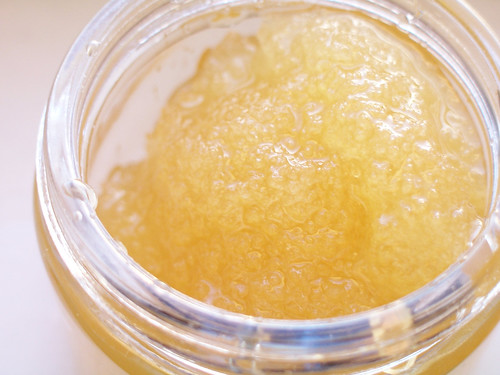Honey is one of natures' best energy foods because it contains many carbohydrates. It is different from cane sugar, which is also an energy food, because honey also contains small amounts of protein, minerals and vitamins. Honey is the only form of sugar food that does not need to be refined. About four-fifths of extracted honey by weight is sugar, mostly in the form of simple sugars, which are easy to digest because they are already in the form that can be absorbed by the body.
Varieties
Flavor, aroma and color of honey vary with the kind of flowers from which the bees gather the nectar to make the honey. As a rule, the lightest colored honeys are the mildest. Well over half of the honey produced in the US is light-colored, mild-flavored Sweetclover, Clover, or Alfalfa honey.
Crystallization is a natural process that happens over time and is influenced by storage conditions, but does not injure the honey in any way.
To bring crystallized honey back to liquid form, place the container of honey in a pan of warm water until the crystals disappear. If further heating is necessary, raise the container of honey off the bottom of the pan by putting a rack under it and set the pan over low heat. Be careful not to overheat, too much heat causes the honey to change color and flavor.
Honey needs to be treated with care, and, unless using it in baking, should not be heated above 140 degrees, since higher temperatures kill the nutrients it contains; which is why using a microwave to soften crystallized honey should be avoided.
Cooking with Honey
Honey can be substituted for regular sugar in most recipes without very noticable taste differences. In some cases, like cakes and cookies, it will make them soft and chewy, more so than using regular sugar because of the moisture content.
If your recipe calls for 1 cup of white sugar, substitute 3/4 cup honey, and reduce the liquid in the recipe by 1/4 cup. This is necessary because honey contains liquid. If the recipe does not contain liquid, add 4 Tbsp. of additional flour for each 3/4 c. of honey used.
Honey carmelizes at a low temperature. Bake cakes or other baked products made with honey with an oven temperature 25 degrees lower than those made with sugar. Otherwise, they may brown outside before they are sufficiently baked inside.
To make preserves (jam) with honey, follow your favorite recipes and substitute honey for sugar. The honey will combine well with flavorings apt to be found in preserves, such as allspice, nutmeg, mace, cinnamon, cloves and lemon or orange juice.
Storing Honey
Temperature: Room Temperature (~70-80 degrees F.). Honey should not be allowed to get too hot or freeze – this will encourage crystallization.
Oxygen: Removing oxygen for long term honey storage is not required and not recommended.
Packaging: Glass canning jars and #10 cans work best. Often times the plastic containers that honey is purchased in will "expire" before the honey will. Extracted and comb honey keep best in covered containers. Because honey loses aroma and flavor and absorbs moisture and odors readily when exposed to air, a cover is necessary.
Storing: Store in a cool, dark, dry place, at room temperature, or where temperatures stay moderately the same.
Creamed honey may be kept at room temperature or in the refrigerator. Keep in the refrigerator if the temperature of the room is very warm. Freezing or refrigeration will not harm the honey, but may hasten granulation. Creamed honey may partially liquify if stored at too high a temperature.
Keep honey covered in the refrigerator if it has been diluted with water or any other liquid.
Shelf Life: Indefinite – although best if used within 2 years for quality concerns (crystallization).
Honey kept for many months may darken slowly and become stronger in flavor, but will still be safe to consume. Honey may crystallize as it gets older, or if kept at refrigerator temperatures.
Filtered vs. Raw: Commercial, filtered liquid honey is the 'runny' honey that most consumers buy. It is good for spreading on bread, etc. 'Raw' honey crystallizes a lot sooner than filtered honey, and requires some work getting it back to the liquid state.
Sources:
- "The Wooden Spoon". A cooking school dedicated to providing information, instruction and enthusiasm to bring the family back to th table! The Guest House. 241 W. Main Street American Fork, Utah.


No comments:
Post a Comment